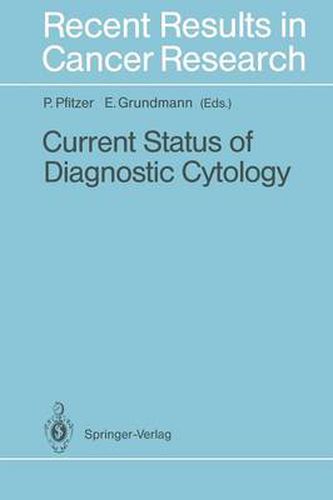Readings Newsletter
Become a Readings Member to make your shopping experience even easier.
Sign in or sign up for free!
You’re not far away from qualifying for FREE standard shipping within Australia
You’ve qualified for FREE standard shipping within Australia
The cart is loading…






This title is printed to order. This book may have been self-published. If so, we cannot guarantee the quality of the content. In the main most books will have gone through the editing process however some may not. We therefore suggest that you be aware of this before ordering this book. If in doubt check either the author or publisher’s details as we are unable to accept any returns unless they are faulty. Please contact us if you have any questions.
Progress in science is often promoted by a new method. Diagnostic cytology, however, developed slowly over a whole century, mainly in differentiating malignant from benign cells from various tissues. The decisive step in this development was the intensive investigation of one local ization by Papanicolaou: The application of cytology for screening in the field of gynecologic oncology made it an acknowledged technique. Consequently, materials inves tigated before were tested again on a larger scale and new ones were included into the program. The possibility of a wide-range application of this diag nostic method, which carries a low risk for the patient and is low in cost, attracted the specialists of many fields. One of the problems which has resulted is the coordination of training and quality assurance for a large group of people from different fields and with different interests and whose experience in morphology varies. In this volume general problems of cytology are dis cussed, as is the question who is a medical cytologist? Education and training are the topics of the contributions by Coleman, Holzner, Jenny, Koss and Muller, cover ing the situation in the European Community, Germany, Austria, Switzerland, and the USA. A special contribu tion by Lange concerns the situation of cytotechnologists, paramedicals important for cytologic screening programs.
$9.00 standard shipping within Australia
FREE standard shipping within Australia for orders over $100.00
Express & International shipping calculated at checkout
This title is printed to order. This book may have been self-published. If so, we cannot guarantee the quality of the content. In the main most books will have gone through the editing process however some may not. We therefore suggest that you be aware of this before ordering this book. If in doubt check either the author or publisher’s details as we are unable to accept any returns unless they are faulty. Please contact us if you have any questions.
Progress in science is often promoted by a new method. Diagnostic cytology, however, developed slowly over a whole century, mainly in differentiating malignant from benign cells from various tissues. The decisive step in this development was the intensive investigation of one local ization by Papanicolaou: The application of cytology for screening in the field of gynecologic oncology made it an acknowledged technique. Consequently, materials inves tigated before were tested again on a larger scale and new ones were included into the program. The possibility of a wide-range application of this diag nostic method, which carries a low risk for the patient and is low in cost, attracted the specialists of many fields. One of the problems which has resulted is the coordination of training and quality assurance for a large group of people from different fields and with different interests and whose experience in morphology varies. In this volume general problems of cytology are dis cussed, as is the question who is a medical cytologist? Education and training are the topics of the contributions by Coleman, Holzner, Jenny, Koss and Muller, cover ing the situation in the European Community, Germany, Austria, Switzerland, and the USA. A special contribu tion by Lange concerns the situation of cytotechnologists, paramedicals important for cytologic screening programs.